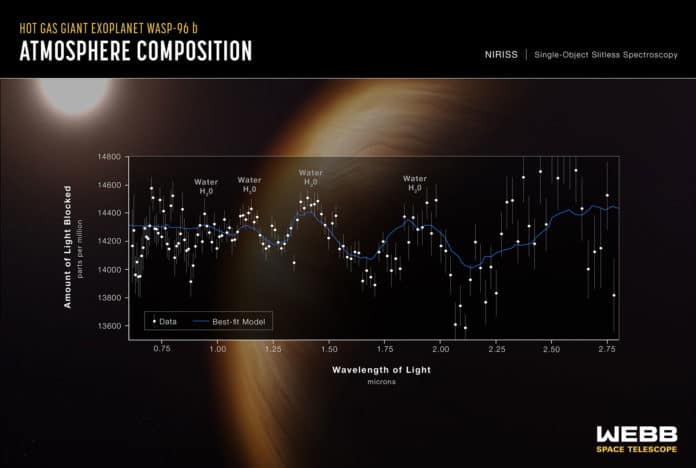NASA/ESA’s Hubble Space Telescope has analyzed numerous exoplanet atmospheres over the past two decades. It captured the first clear detection of water in 2013. Now, NASA’s James Webb Space Telescope marks a giant leap forward in the quest to characterize potentially habitable planets beyond Earth.
Recently, Webb has detected the distinct signature of water in the atmosphere surrounding a hot, puffy gas giant planet called WASP-96 b- orbiting a distant Sun-like star. Observation unveils the presence of specific gas molecules based on tiny decreases in the brightness of precise colors of light.
Because of its unprecedented ability to analyze atmospheres hundreds of light-years away, this new observation is the most detailed of its kind to date. There are more than 5,000 known exoplanets in the Milky Way, including WASP-96 b. It is a type of gas giant with no direct counterpart in our solar system and is about 1,150 light-years away in the southern-sky constellation Phoenix.
WASP-96 b is the puffiest planet in our solar system, with a diameter 1.2 times larger and a mass less than half that of Jupiter. And with a temperature greater than 1000°F, it is significantly hotter. WASP-96 b orbits its Sun-like star every 312 Earth days, orbiting it at a distance that is just one-ninth of the distance between Mercury and the Sun.
Due to its large size, short orbital period, puffy atmosphere, and lack of contaminating light from objects nearby in the sky, WASP-96 b is an ideal target for atmospheric observations.
The WASP-96 system was observed by Webb’s Near-Infrared Imager and Slitless Spectrograph (NIRISS) on June 21 for 6.4 hours while the planet moved across the star. The result is a light curve that illustrates the overall dimming of starlight during the transit and a transmission spectrum that demonstrates the brightness variation of distinct infrared light wavelengths between 0.6 and 2.8 microns.
The light curve confirms the properties of the planet. In contrast, the transmission spectrum reveals previously unknown details of the atmosphere: the unambiguous signature of water, indications of haze, and evidence of clouds that were thought not to exist based on prior observations.
NASA mentioned, “The spectrum of WASP-96 b captured by NIRISS is not only the most detailed near-infrared transmission spectrum of an exoplanet atmosphere captured to date, but it also covers a remarkably wide range of wavelengths, including visible red light and a portion of the spectrum that has not previously been accessible from other telescopes.”
“This part of the spectrum is susceptible to water and other key molecules like oxygen, methane, and carbon dioxide, which are not immediately obvious in the WASP-96 b spectrum but should be detectable in other exoplanets planned for observation by Webb.”
“Researchers will be able to use the spectrum to measure the amount of water vapor in the atmosphere, constrain the abundance of various elements like carbon and oxygen, and estimate the atmosphere’s temperature with depth. They can then use this information to make inferences about the overall make-up of the planet, as well as how, when, and where it formed. The blue line on the graph is a best-fit model that considers the data, the known properties of WASP-96 b and its star (e.g., size, mass, temperature), and assumed characteristics of the atmosphere.”
“The exceptional detail and clarity of these measurements are possible because of Webb’s state-of-the-art design. Its 270-square-foot gold-coated mirror collects infrared light efficiently. Its precision spectrographs spread light out into rainbows of thousands of infrared colors. And its sensitive infrared detectors measure extremely subtle differences in brightness. NIRISS can detect color differences of only about one-thousandth of a micron (the difference between green and yellow is about 50 microns) and differences in the brightness between those colors of a few hundred parts per million.”
